Skin Cancer
Understanding Skin Cancer: Symptoms, Prevention, and Treatment
Skin cancer is the most common form of cancer in the United States. It occurs when abnormal skin cells grow uncontrollably, often due to prolonged exposure to ultraviolet (UV) radiation from the sun or tanning beds. These abnormal cells can appear as changes in existing moles, new growths, or non-healing spots on the skin.
1 in 5 Americans will develop skin cancer in their lifetime, making awareness, prevention, and early detection more critical than ever. Whether you’re monitoring your skin for changes, managing a diagnosis, or seeking preventive care, understanding the signs, risk factors, and treatment options is essential for protecting your long-term health.
Skin cancer occurs when abnormal cells grow uncontrollably in the skin, often starting with changes in moles or new growths. The three most common forms of skin cancer are melanoma, basal cell carcinoma, and squamous cell carcinoma.
The Importance of Early Detection in Skin Cancer Prevention
Early detection is crucial for effective treatment and achieving the best outcomes. Regular full-body skin examinations by a dermatologist are essential for identifying skin cancer early. Annual skin checks can catch changes in moles or new growths before they become more serious.
At Pinnacle Dermatology, we are dedicated to helping you achieve and maintain your skin’s best health through education, prevention, and the early detection of skin cancer. Our focus on skin health and positive outcomes is at the core of everything we do, which is why we offer a total body skin exam as part of your annual appointment.
Total body skin exams allow our providers to thoroughly analyze the overall health of your skin and check for any conditions or spots that may be of concern. By incorporating regular skin checks into your routine, you can take a proactive step towards protecting your skin and ensuring early intervention if needed.
Schedule your comprehensive skin exam with Pinnacle Dermatology today and take charge of your skin health. Your well-being is our top priority, and we are here to support you every step of the way.
The Importance of Skin Checks
How Skin Cancer Develops
Skin cancer begins when the DNA in skin cells becomes damaged and the body can no longer repair it effectively. This damage causes cells to grow and divide uncontrollably, forming abnormal growths or tumors.
These cancerous changes can originate in normal skin or develop from existing moles that begin to change in size, shape, or color. While not all skin changes are cancerous, new or evolving lesions should always be evaluated by a dermatologist to ensure early detection and treatment.
Examples of Skin Cancer
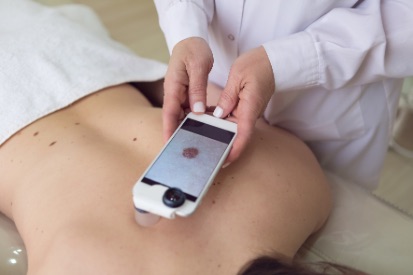
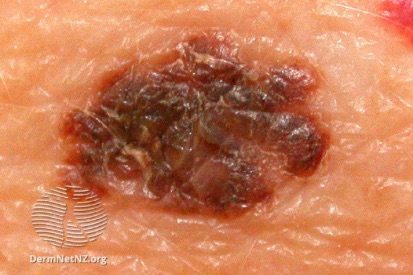

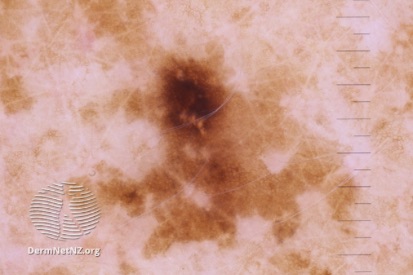
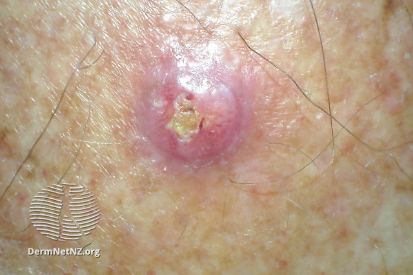
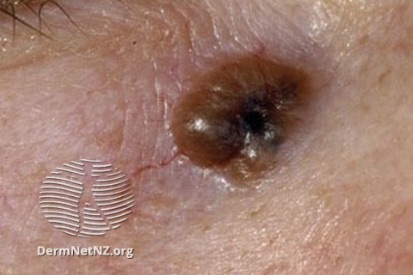
Types of Skin Cancer
Skin cancer is not a single disease, but rather a group of cancers that begin in the skin. The three most common types are basal cell carcinoma (BCC), squamous cell carcinoma (SCC), and melanoma, each varying in appearance, severity, and potential for spreading. Understanding the unique traits of each type is essential for early recognition and treatment. Below, we explore the characteristics of these major skin cancers.
Basal Cell Carcinoma (BCC)
Basal cell carcinoma is the most common type of skin cancer, developing in the basal cells located in the lower layer of the epidermis. It typically appears as a pearly or waxy bump, a flat, flesh-toned or brown scar-like patch, or a sore that repeatedly bleeds and heals.
While BCC grows slowly and is usually painless, it can cause significant skin damage if left untreated. It most often occurs on sun-exposed areas such as the face, ears, neck, scalp, shoulders, and back.
Squamous Cell Carcinoma (SCC)
Squamous cell carcinoma develops in the squamous cells, which form the outermost layers of the skin. It often appears as a firm, red bump or a flat lesion with a rough, scaly, or crusted surface.
Although less aggressive than melanoma, SCC can grow quickly and potentially spread to deeper tissues or other areas of the body. Risk factors for SCC include prolonged exposure to UV radiation, a history of frequent sunburns, fair skin, and weakened immune function.
Melanoma
Melanoma is the most serious and aggressive form of skin cancer. While it occurs less frequently than BCC or SCC, it accounts for the majority of skin cancer-related deaths because it can spread quickly to other parts of the body.
Melanoma can develop from an existing mole or appear as a new, unusual growth anywhere on the body, including areas that aren’t regularly exposed to sunlight. These lesions may vary widely in color, ranging from black or brown to pink, red, or even skin-toned. Early detection is essential for improving outcomes, and one of the most effective ways to recognize warning signs is by using the ABCDE rule.
Use this guide to help identify suspicious moles or skin changes:
- A – Asymmetry: One half of the mole or spot doesn’t match the other
- B – Border: Edges are irregular, scalloped, or poorly defined
- C – Color: Uneven color or multiple shades (brown, black, red, white, or blue)
- D – Diameter: Larger than 6mm (about the size of a pencil eraser)
- E – Evolving: The spot is changing in size, shape, color, or is starting to itch, bleed, or crust
Understanding the ABCDEs of Melanoma
How to Spot Skin Cancer
Skin cancer can present in various ways, which is why it’s important to stay alert to any changes in your skin. Recognizing subtle or persistent skin changes early can significantly impact diagnosis and treatment outcomes for skin cancer. If you notice anything unusual, it’s best to consult a dermatologist at Pinnacle Dermatology for a professional evaluation.
Common skin cancer symptoms include:
- Changes in the size, shape, or color of existing moles
- New growths or spots that look different from other areas of your skin
- Sores or lesions that don’t heal, or heal and return
- Bumps that are pearly, waxy, or have a translucent appearance
- Rough, scaly patches or crusted areas on the skin
What Causes Skin Cancer?
As mentioned above, skin cancer often begins with damage to the DNA of skin cells, most commonly from ultraviolet radiation. Over time, this damage can lead to abnormal cell growth and cancer development.
At Pinnacle Dermatology, we understand the many factors contributing to skin cancer risk. We are committed to helping you identify and manage those risks through expert care, personalized prevention strategies, and routine skin exams.
Common skin cancer causes include:
- Excessive UV exposure from the sun or artificial sources like tanning beds
- Frequent sunburns, especially during childhood or adolescence
- Fair skin, light hair, and light-colored eyes (lower melanin levels mean less natural protection)
- A history of skin cancer or precancerous lesions
- Weakened immune system, due to illness or medications
- Exposure to toxic substances, such as arsenic
- Genetic factors or a family history of skin cancer
- Chronic skin inflammation or injuries in the same area over time
How to Prevent Skin Cancer
While skin cancer is one of the most common cancers, it’s also one of the most preventable. Every day presents an opportunity to protect your skin and reduce your risk through simple, consistent habits. From daily sun safety to staying aware of changes in your skin, skin cancer prevention starts with awareness—and ends with action.
At Pinnacle Dermatology, we empower our patients with the knowledge and care they need to take charge of their skin health. Through daily protection, self-checks, and annual total body skin exams, you can stay one step ahead and safeguard your health for the long term.
Daily Protection Habits
Daily protection starts with healthy skin habits. Use a broad-spectrum sunscreen with SPF 30 or higher every day, even on cloudy days, and reapply regularly. Wear protective clothing like wide-brimmed hats and long sleeves, and seek shade during peak sun hours (10 a.m. to 4 p.m.) to minimize UV exposure.
Importance of Regular Skin Self-Exams
Perform a monthly skin cancer self-exam to check for new moles or changes in existing spots. Use a mirror to examine all areas of your body, including hard-to-see places. If you notice anything suspicious, such as changes in shape, color, or size, schedule a visit with a dermatologist immediately.
Annual Total Body Skin Exams at Pinnacle Dermatology
An annual total body skin exam with a Pinnacle Dermatology provider offers a thorough, professional evaluation of your skin. During the exam, we check for any abnormal moles, lesions, or changes. Early detection dramatically improves treatment success, making these yearly exams vital to your skin health routine.
Skin Cancer Diagnosis
Accurate diagnosis is the first and most crucial step in identifying skin cancer and determining the appropriate treatment. At Pinnacle Dermatology, we use a combination of clinical expertise and advanced diagnostic tools to evaluate any areas of concern. Here’s what you can expect during the diagnostic process:
- Clinical Skin Exam: A thorough visual inspection of your skin by a board-certified dermatologist to identify abnormal or suspicious moles, lesions, or growths.
- Dermoscopy: A handheld device called a dermatoscope magnifies and illuminates the skin, revealing structures and patterns beneath the surface that help distinguish benign from malignant lesions.
- Biopsy: If an area appears suspicious, your provider may remove a small sample of tissue for laboratory analysis to confirm whether cancer cells are present.
Skin Cancer Treatments
Receiving a skin cancer diagnosis can feel overwhelming, but treatment options today are highly effective, especially when the condition is caught early. At Pinnacle Dermatology, we provide personalized care plans tailored to your specific type, stage, and location of cancer. Whether your treatment involves non-surgical methods or advanced surgical techniques, our experienced providers are here to guide you every step of the way.
Non-Surgical Treatments
For certain types and early stages of skin cancer, non-surgical options can be effective. These may include topical medications, cryotherapy (freezing), or targeted therapies that destroy cancer cells without incisions. Your Pinnacle Dermatology provider will determine if a non-invasive approach is appropriate for your condition.
Surgical Treatments
Surgical treatments are often the most effective option for removing skin cancer, especially in more advanced or high-risk cases. Procedures may include excisional surgery or Mohs micrographic surgery, which precisely removes cancerous tissue while preserving healthy skin. Pinnacle Dermatology offers expert surgical care tailored to your needs and diagnosis.
Take Charge of Your Skin Health With Pinnacle Dermatology
Your skin is your body’s first line of defense. Protect it with expert care from the trusted team at Pinnacle Dermatology. Whether you need a routine skin check, are monitoring a suspicious spot, or require treatment for a confirmed diagnosis, our dermatology professionals are here to support you. Book your appointment now and let Pinnacle Dermatology be your partner in prevention, detection, and treatment.
Skin Cancer FAQs
Skin cancer is the abnormal growth of skin cells, usually caused by damage from ultraviolet radiation. It may occur anywhere on the body and ranges in severity from easily treatable to potentially life-threatening if left undetected.
Risk factors include frequent sun exposure, tanning bed use, fair skin, a history of sunburns, a weakened immune system, a family history of skin cancer, and having many moles or atypical moles.
Common skin cancer signs include changes in existing moles, new or unusual growths, and sores that don’t heal. Use the ABCDE rule (Asymmetry, Border, Color, Diameter, Evolving) to monitor suspicious spots.
Treatment depends on the type and stage of the cancer. Options include non-surgical methods like topical creams or cryotherapy and surgical procedures such as excision or Mohs surgery for more advanced cases.
Sunscreen should be applied daily, even on cloudy days or during winter. Reapply every two hours, or more frequently if swimming or sweating.
A total body skin exam helps detect skin cancer at its earliest, most treatable stage. At Pinnacle Dermatology, we offer comprehensive annual exams to ensure your skin stays healthy and monitored by experts.
Featured Blogs

- Skin Cancer
- Skin Exams
- Sun Safety
When it comes to skin cancer detection, the saying "better safe than sorry" couldn't be more appropriate.
Read More
- Skin Cancer
- General Dermatology
- Skin Exams
Navigating the landscape of Total Body Skin Exams: Uncover the comprehensive process, understand why it matters for skin health, and gain insights into what to expect during these essential dermatological examinations.
Read More
- Skin Cancer
- Skin Exams
Skin Cancer Prevention: 5 tips and tricks for your skin's protection.
Read MoreFeatured Products for Sun Protection

EltaMD UV Luminous Broad-Spectrum SPF 41
Get a shade more luminous with our newest lightly tinted sunscreen that brings skin care and essential sun care together. EltaMD UV Luminous Broad-Spectrum SPF 41 uses antioxidants such as linoleic acid and vitamin E to protect your skin from free radicals and diminish UV-related signs of aging. It’s light rosy tint and semi-matte finish blends into the skin seamlessly and blurs imperfections. EltaMD UV Luminous Broad-Spectrum SPF 41 sunscreen is ideal for those seeking non-greasy UV protection with all physical active ingredients. Net wt 1.7 oz/48 g

EltaMD UV Sheer Broad-Spectrum SPF 50
UV Sheer has a lightweight, hydrating formula that feels silky to the touch and light and airy on the skin. It goes on smooth absorbing quickly into skin and helps even out skin tone. This facial sunscreen offers up to 80 minutes of sweat and water-resistance making it the ideal choice for an active lifestyle, hot and humid weather and for anyone looking for a lightweight and hydrating sunscreen to live freely under the sun. UV Sheer is formulated to be compatible on all skin tones without leaving a white cast. 3.0 oz


